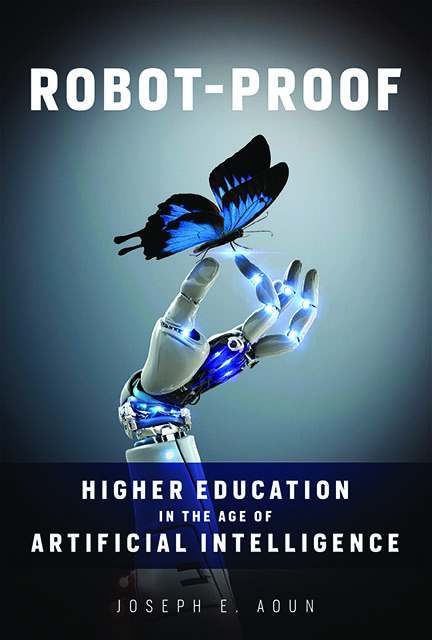How to Be Robot-Proof

In his new book, Robot-Proof: Higher Education in the Age of Artificial Intelligence, Northeastern University president Joseph Aoun, PhD ’82, says universities must rethink how they prepare students for a world where advances in technology are continually changing the workplace landscape—and making many traditional jobs obsolete.
Simply pursuing a traditional liberal arts education or a technical education will not be enough to make graduates “robot-proof,” or safe from being replaced by technology, says Aoun, who earned his MIT doctorate in linguistics and philosophy. “In higher education we have created a false dichotomy between learning to live and learning to earn a living,” he says. “What I am calling for is to break down the silos between liberal arts literacies and tech literacies. We need an intentional integration, and this is what I outline in the book.”
In Robot-Proof, Aoun advises colleges and universities to augment their traditional offerings with three new components. The first is a curriculum for what he calls “robot-proof education.” As he writes, “The field of robotics is yielding the most advanced generation of machines in history, so we need a disciplinary field that can do the same for human beings.” He says this new field, which he calls “humanics,” requires students to master technical literacy, or understanding machines and how they function; data literacy, or understanding the products of these machines; and human literacy, “the domain where machines cannot compete with us, namely the ability to be creative, entrepreneurial, culturally agile, global, and so on.”
The second component is experiential learning—think co-ops and internships—that will prepare students for jobs. Aoun has been a strong proponent of this tactic at Northeastern, which he has led since 2006; 97 percent of its students take advantage of its co-op program before graduating.
The third component is a commitment to providing opportunities for lifelong learning. Many employers have embraced the idea of extending education well beyond the undergraduate years, and Aoun believes universities must do so as well.
A key part of preparing people for an unknowable future is to give them tools that will help them adapt to change. Aoun says he is finding that today’s students have figured that out. “When I started thinking about the book and writing, I started talking to the students, and to my delight and surprise, the AI revolution and smart machines and robots—they already were thinking about it. Why? Because they knew they were going to live it,” he says. “So through various conversations with the students, it dawned on me that in some ways, they are ahead with respect to the rest of us. They are ahead because they realize they are entering into this new world.”
Recent Books
From the MIT Community
Robot-Proof: Higher Education in the Age of Artificial Intelligence
By Joseph E. Aoun, PhD ’82
MIT Press, 2017, $24.95
Deadly Clerics: Blocked Ambition and the Paths to Jihad
By Richard A. Nielsen, assistant professor of political science
Cambridge University Press, 2017, $29.99
The Longevity Economy: Unlocking the World’s Fastest-Growing, Most Misunderstood Market
By Joseph F. Coughlin, founder and director of the MIT AgeLab
PUblicAffairs, 2017, $28
Science for the Curious Photographer: An Introduction to the Science of Photography, 2nd Edition
Charles S. Johnson Jr., PhD ’61
Routledge/Focal Press, 2018, $49.95
Joint Fact-Finding in Urban Planning and Environmental Disputes
Edited by Masahiro Matsuura, MCP ’98, PhD ’06; Todd Schenk, MCP ’09, PhD ’15
Routledge, 2017, $53.95
Life in the Age of Drone Warfare
Edited by Lisa Parks, professor of comparative media studies, and Caren Kaplan
Duke University Press, 2017, $29.95
Introduction to Refrigeration and Air Conditioning Systems: Theory and Applications
By Allan T. Kirkpatrick ’72, PhD ’81
MOrgan & Claypool, 2017, $39.95
“Measuring the Adaptation Gap: A Framework for Evaluating Climate Hazards and Opportunities in Urban Areas”
By Joyce Coffee, MCP ’99; Chen Chen; Meghan Doherty; Theodore Wong; and Jessica Hellmann
Environmental Science and Policy, December 2016
Please submit titles of books and papers published in 2017 and 2018 to be considered for this column.
Contact MIT News
E-mail mitnews@technologyreview.com
Write MIT News, One Main Street, 13th Floor, Cambridge, MA 02142
Keep Reading
Most Popular
Large language models can do jaw-dropping things. But nobody knows exactly why.
And that's a problem. Figuring it out is one of the biggest scientific puzzles of our time and a crucial step towards controlling more powerful future models.
The problem with plug-in hybrids? Their drivers.
Plug-in hybrids are often sold as a transition to EVs, but new data from Europe shows we’re still underestimating the emissions they produce.
Google DeepMind’s new generative model makes Super Mario–like games from scratch
Genie learns how to control games by watching hours and hours of video. It could help train next-gen robots too.
How scientists traced a mysterious covid case back to six toilets
When wastewater surveillance turns into a hunt for a single infected individual, the ethics get tricky.
Stay connected
Get the latest updates from
MIT Technology Review
Discover special offers, top stories, upcoming events, and more.